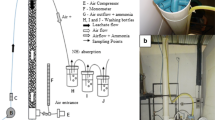Abstract
In this study a pilot plant for electrodialytic treatment of municipal solid waste incineration (MSWI) air pollution control (APC) residue was tested and proposed as a treatment method which can lead to reuse of this otherwise hazardous waste. The pilot plant was developed based on a design that is adapted from conventional electrodialysis, e.g. used in desalination of solutions. The APC residue was treated in a suspension (8 kg APC residue and 80 L tap water) and circulated through an electrodialytic (ED) stack consisting of 50 cell pairs separated by ion exchange membranes. A direct current was applied to the ED stack for removal of heavy metals (As, Ba, Cd, Cr, Cu, Mn, Ni, Pb, Zn) and salts (Cl, Na, SO4) from the APC residue suspension. Different tank designs for mixing the APC residue suspension were tested as well as changing experimental conditions. A part of the raw experimental APC residue was carbonated by reaction with CO2 under moist conditions prior to electrodialytic treatment. The carbonation alone reduced the leaching of some heavy metals. However, it was not sufficient to reduce the heavy metal or salt leaching to meet the Danish Category 3 guideline levels for waste material reuse and could not stand as a treatment method alone. Leaching of both heavy metals and salts were significantly reduced by the electrodialytic treatment for both the raw and carbonated APC residue. In the electrodialytically treated carbonated APC residue only Cr exceeded the Category 3 levels while in the electrodialytically treated raw APC residue both Pb and Zn leaching exceeded the Category 3. Optimization of the electrodialytic upgrading method is necessary to meet the Category 3 levels for all heavy metals. Removal of Na and SO4 to below the Category 3 leaching levels were obtained in all the experiments. Cl removal was not sufficient in all experiments even if up to 1 kg of Cl was removed, the optimal conditions for Cl removal was a constant current of 5 A over the ED stack. The results of this study suggest that, with some optimization, electrodialytic upgrading, possibly in combination with carbonation, could be used as a treatment method for MSWI APC residue.








Similar content being viewed by others
References
Ferreira C, Ribeiro A, Ottosen L (2003) J Hazard Mater B96:201
Aubert JE, Husson B, Sarramone N (2006) J Hazard Mater B136:624
Pederesen AJ (2002) Electrodialytic removal of heavy metals from fly ashes. PhD thesis, Department of Civil Engineering, Technical University of Denmark
Ferreira C (2005) Removal of heavy metals from municipal solid waste incinerator fly ash by an electrodialytic process. PhD thesis, Department of Civil Engineering, Technical University of Denmark
Ottosen LM, Hansen HK, Hansen C (2000) J Appl Electrochem 30:1199
Nystroem GM, Ottosen LM, Villumsen A (2005) Sep Sci Technol 40:2245
Jensen PE, Ottosen LM, Ferreira C (2007) Electrochim Acta 52:3412
Ottosen LM, Lima AT, Pedersen AJ, Ribeiro AB (2006) J Chem Technol Biotechnol 81:553
Pedersen AJ (2002) J Hazard Mater B95:185
Pedersen AJ, Gardner KH (2003) J Phys IV 107:1029
Jensen PE, Ferreira CMD, Hansen HK, Rype JU, Ottosen LM, Villumsen A (2009) J Appl Electrochem (submitted)
Dansk Standardiseringsråd (1991) Vandundersøgelse. Metal ved atomabsorptionsspektrofotometri i flamme. Almene principper og retningslinjer. In: Standarder for Vand of Miljø, Fysiske og Kemiske Metoder, Det 1, a-offset, Holstebro, 1991, p 138 (in Danish)
Loeppert RH, Suarez DL (1995) Carbonate and gypsym. In: Bingham JM (ed) Methods of soil analysis, part 3—chemical methods. SSSA book series no. 5. American Society of Agronomy, Madiscon, p 437
Pedersen AJ, Frandsen FJ, Riber C, Astrup T, Thomsen SN, Lundtorp K, Mortensen LF (2009) Energy Fuels 23:3475
Danish Ministry of the Environment (2007) Bekendtgørelse om genanvendelse af restprodukter og jord til bygge- og anlægsarbejder BEK nr 1480 af 12/12/2007 (in Danish)
Ecke H (2003) Waste Manage 23:631
Aguiar del Toro M, Calmano W, Ecke H (2009) Waste Manage 29:2494
Martell AE (ed) (1976) Critical stability constants. In: Inorganic complexes, vol 4. Plenum Press, New York, p 257
Jianguo J, Maozhe C, Yan Z, Xin X (2009) J Hazard Mater 161:1046
Acknowledgements
We are grateful to REFA I/S for providing the experimental APC residue and hosting the pilot plant facilities. The Danish Agency for Science Technology and Innovation financed the pilot plant test period through Proof of Concept funding.
Author information
Authors and Affiliations
Corresponding author
Rights and permissions
About this article
Cite this article
Kirkelund, G.M., Jensen, P.E., Villumsen, A. et al. Test of electrodialytic upgrading of MSWI APC residue in pilot scale: focus on reduced metal and salt leaching. J Appl Electrochem 40, 1049–1060 (2010). https://doi.org/10.1007/s10800-009-0059-0
Received:
Accepted:
Published:
Issue Date:
DOI: https://doi.org/10.1007/s10800-009-0059-0




